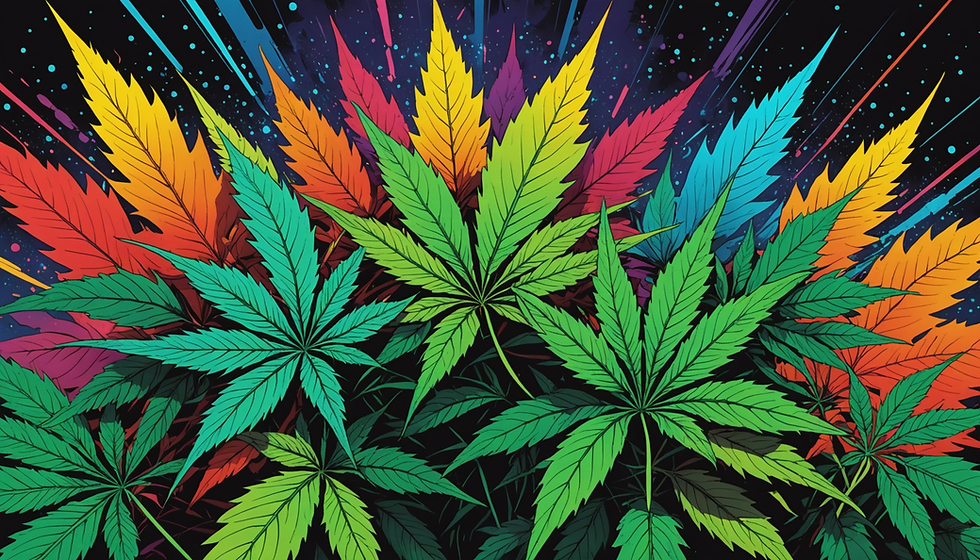Exploring the Diverse World of Cannabinoids: A Comprehensive Overview
- The Lifted Leaf
- Jan 19
- 3 min read
Updated: Jan 27

Introduction: Beyond THC and CBD
While Δ⁹-tetrahydrocannabinol (Δ⁹-THC) and cannabidiol (CBD) often dominate discussions surrounding cannabis, the Cannabis sativa plant produces a diverse array of cannabinoids, each with unique chemical structures and potential effects. This article provides a concise overview of several key cannabinoids—Δ⁹-THC, Δ⁸-THC, Δ¹⁰-THC, CBD, CBG, CBN, THCA, THC-V, THC-P, THC-O, and HHC—exploring their properties, potential applications, and the need for further research.
Understanding Cannabinoid Structure and Function
Cannabinoids share a common chemical structure, but variations in their molecular arrangement lead to significant differences in their interactions with the body's endocannabinoid system (ECS) and other biological targets (Hanuš et al., 2019). The ECS plays a vital role in regulating various physiological processes, including mood, pain perception, appetite, and sleep (Pertwee, 2008). Cannabinoids bind to different receptors within the ECS with varying affinities, leading to a diverse range of potential effects. For instance, Δ⁹-THC primarily interacts with CB1 receptors, resulting in psychoactive effects (Howlett et al., 2002), while CBD exhibits less affinity for these receptors but may interact with other targets (Izzo et al., 2019).
A Spectrum of Cannabinoids

Δ⁹-THC: The primary psychoactive component of cannabis, associated with euphoria, relaxation, altered perception, and potential therapeutic applications such as appetite stimulation and pain relief (Abrams, 2007).
Δ⁸-THC: An isomer of Δ⁹-THC, potentially producing milder psychoactive effects.
Δ¹⁰-THC: Another isomer of Δ⁹-THC, possibly with milder psychoactive effects.
THCA: The acidic precursor to Δ⁹-THC, exhibiting potential therapeutic benefits without psychoactive effects.
THC-V: A minor cannabinoid with potential appetite-suppressing properties, attracting interest in weight management strategies.
THC-P: A recently emerged, highly potent cannabinoid requiring further research to establish its effects and safety profile.
THC-O: A chemically modified form of THC with potentially more potent and prolonged psychoactive effects, needing substantial research to determine its safety and therapeutic potential.
HHC: A hydrogenated form of THC, potentially possessing milder and longer-lasting psychoactive effects.
CBD: A non-psychoactive cannabinoid with growing interest in its therapeutic potential, including anti-inflammatory, analgesic, anxiolytic, and neuroprotective effects (Shannon et al., 2019).
CBG: A precursor molecule for other cannabinoids, showing potential therapeutic benefits such as anti-inflammatory and neuroprotective effects (Bormann et al., 2021).
CBN: A non-psychoactive cannabinoid formed through THC degradation, potentially possessing analgesic, sedative, and neuroprotective properties (Russo, 2011).
The Importance of Further Research
While some cannabinoids have been studied more extensively than others, further research is essential to fully elucidate their mechanisms of action, therapeutic potential, and safety profiles. The limited research on many of these cannabinoids necessitates cautious interpretation of anecdotal reports and a focus on rigorous scientific investigation.
Legal Considerations
The legal status of cannabinoids is complex and varies across jurisdictions. This dynamic legal landscape underscores the importance of staying informed about local regulations.
Conclusion: A Diverse Field Requiring Continued Investigation
The world of cannabinoids is vast and diverse, with many compounds yet to be fully understood. Continued research is critical to unraveling their potential therapeutic benefits and associated risks, informing responsible use, development, and regulation.
References
Abrams, D. I. (2007). Cannabis and cannabinoids: potential therapeutic applications. Expert opinion on investigational drugs, 16(11), 1773-1780.
Bormann, J., et al. (2021). Cannabigerol (CBG): A promising phytocannabinoid for therapeutic applications. Molecules, 26(5), 1311.
ElSohly, M. A., & Gul, W. (2014). Cannabis sativa: the genus Cannabis. Cannabis and cannabinoids, 1, 1-14.
Hanuš, L. O., et al. (2019). Isomerization of CBD to Δ8-THC. Journal of Natural Products, 82(6), 1661-1668.
Howlett, A. C., et al. (2002). International Union of Pharmacology. XXVII. Classification of cannabinoid receptors. Pharmacological reviews, 54(2), 161-202.
Izzo, A. A., et al. (2019). The pharmacological potential of cannabigerol (CBG): a review of preclinical studies. Cannabis and Cannabinoid Research, 4(1), 1-11.
Pertwee, R. G. (2008). The diverse CB1 and CB2 receptor pharmacology of cannabinoids. British journal of pharmacology, 153(2), 199-215.
Russo, E. B. (2011). Taming THC: potential cannabis synergy and phytocannabinoid-terpenoid entourage effects. British Journal of Pharmacology, 163(7), 1344-1364.
Shannon, S., et al. (2019). Cannabidiol in anxiety and sleep: a large case series. The Permanente Journal, 23, 18-041.




